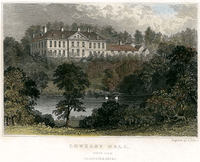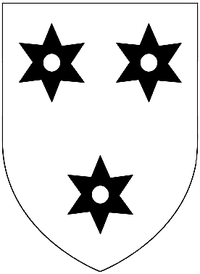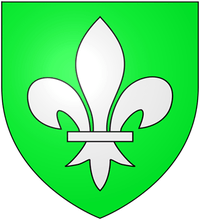Lowesby Hall


Lowesby Hall is a large Grade II* Georgian mansion in the parish and former manor of Lowesby, eight miles east of Leicester in Leicestershire. It is a famous fox-hunting seat in the heart of the Quorn country. The poem "Lowesby Hall" by the Victorian English foxhunting MP William Bromley Davenport (1821–1884) was a parody on Alfred Tennyson's 1835 poem Locksley Hall.[1]
History
Wollaston

In the mid-17th.century the manor of Lowesby was acquired by Richard Wollaston (1635–1691), son of Henry Wollaston, a citizen of London in 1669, himself the younger brother of Sir John Wollaston (died 1658), Lord Mayor of London in 1643, and second son of Edward Wollaston of Perton in Staffordshire by his wife and cousin Elizabeth Wollaston of Trescot Grange, Staffordshire.[3] He was thus descended from a junior branch of the Wollaston family anciently from Staffordshire and later settled at Shenton Hall, Leicestershire [4] and Finborough Hall in Suffolk. He appears to have been a gun-founder. A Richard Wollaston served in a man-of-war and in 1650 received a gunner's certificate. He was described in 1650 as a "Master Gunner" on drawing from stores five barrels of gunpowder for a display on the launch of two frigates at Deptford. He has been described as "Cromwell's gun founder", and certainly held a high position in the Ordnance Department and was responsible to the Ordnance Commission.[5] He had two sons Josiah and John (died 1692), who in 1669 purchased from Thomas Johnson a house at Wormley in Hertfordshire then occupied by their father Richard. Also in 1669 John purchased the Manor of Ponsbourne, formerly possessed by Sir Thomas Seymour, Lord Admiral of England. In 1673 Richard purchased a moiety of the manor of Wormley which was inherited by his son John (died 1692) thence to John's son Richard who in 1692 purchased the remaining moiety except the manor house of Wormley Bury. In 1685/8 Richard bequeathed a moietv of 2 farms in Essex to charity. In 1690 a year before his death he applied for the return of the sum of £10,000 he had loaned to the Prince of Orange, by then King William III. The Treasury Records contain the entry: "£140 paid to John Wollaston for the use of his father Richard on a/c of £10,000 part of £20,000 lent the King, and a further £50 on a/c of Poll Tax". Both these were Secret Service payments. On his death in 1691 he left land valued at £100 to the poor forever, £20 for clothing the poor in the parish of Woolmer, £30 to the parish of Whitchurch and £50 for 6 parishes in Leicester.[5] He had the following descendants:
- Josiah Wollaston (1652–1689), son, who predeceased his father. He married Elizabeth Lawrence, sister of Sir Edward Lawrence, 1st Baronet (c. 1674 – 1749). His brother was John Wollaston whose son Richard Wollaston (c. 1678 – 1728) married Faith Brown and was MP for Whitchurch, Hants. 1695–1708.[5]
- Isaac Wollaston (1673–1737), son and heir of Josiah, who married Sarah Lawrence. He was Sheriff of Leicestershire in 1697.
- Sir Isaac Wollaston, 2nd Baronet (died 1750) son and heir, who in 1749 by special remainder succeeded his grandmother's brother Sir Edward Lawrence, 1st Baronet (c. 1674 – 1749) in the Lawrence baronetcy, which title changed thenceforth to the Wollaston baronetcy. His wife died in 1753 leaving as heir an infant son Sir Isaac Lawrence Wollaston, 3rd Baronet.
- Sir Isaac Lawrence Wollaston, 3rd Baronet (died 1756), infant son, on whose death the baronetcy became extinct. The family estates having been divided in 1777 by Act of Parliament between his two sisters, Sarah Wollaston, who later married Taylor White (the son of the barrister and arts patron Taylor White), and Anne Wollaston, who married in 1772 Sir Thomas Fowke (died 1786), (who was knighted in 1777), Lowesby became the share of Lady Fowke,[6][7] and became the seat of the Fowke Baronets, who retained ownership until the 1900s.
Fowke
The house was let by the Fowke family, which moved at some time to Upcott Farm in the parish of Bishops Tawton in Devon,[10] to many subsequent tenants as a residence during the hunting season. The tenant in 1910 was Captain, later Lt-Col., Harold Brassey (c. 1880 – 1916),[7] a polo champion, killed in action during WWII, a younger son of Henry Brassey (1840–1891), JP, DL, MP for Hastings, and brother of Henry Brassey, 1st Baron Brassey of Apethorpe (1870–1958).[11] His grandfather Thomas Brassey (1805–1870) had made a huge fortune as a railway engineer. Brassey commissioned Edwin Lutyens (1866–1944) to alter and extend the Hall and gardens.
Nuttall
Lowesby Hall was sold to the Nuttall family in the 1900s, and was inherited from his father by Sir Nicholas Nuttall, 3rd Baronet (1933–2007) in 1941. Nuttall held a famous party at Lowesby Hall in 1959 to celebrate the restoration of a painted ceiling by Antonio Verrio (later destroyed by fire in 1980),[9] and held a dance in tents at Lowesby in 1976, shortly before he sold it and moved to the Bahamas, emulating a party held by the Shah of Iran in the desert in 1972.
Post 1976
As of 2012 the house remains in private ownership.
References
- ↑ Poems of the Chase, collected and recollected by Sir Reginald Graham, Bart. London, 1912. Lowesby Hall, by W. Bromley Davenport, pp.120-129.
- ↑ Arms of Wollaston of Shenton Hall, Nuneaton, Leicester, (Burke's Landed Gentry, 1937,p.2480) of which family the Wollaston baronets are said to be a junior branch
- ↑ John Burke. A genealogical and heraldic history of the commoners of Great Britain and Ireland, enjoying territorial possessions or high official rank; but uninvested with heritable honours (Volume 3)
- ↑ History of Parliament biography of his grandson Richard Wollaston (c. 1669 – 1728, MP
- 1 2 3 "The Loseby and Wormley Branch". tiscali.co.uk.
- ↑ English Heritage Register of Parks and Gardens of Special Historic Interest, quoted in http://www.parksandgardens.ac.uk/index2.php?option=com_parksandgardens&task=site&id=2162&preview=1&Itemid=
- 1 2 "Lowesby Hall - mansion / manor house / villa". wikimapia.org.
- ↑ Debrett's Peerage, 1967, p.315
- 1 2 Listed Building text
- ↑ Debrett's Peerage, 1967
- ↑ "- Person Page 1570". thepeerage.com.
External links
Coordinates: 52°39′39″N 0°56′03″W / 52.6609°N 0.9343°W
